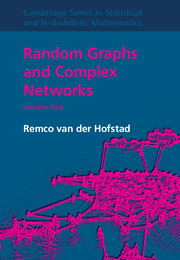Book contents
- Frontmatter
- Dedication
- Contents
- Preface
- Course Outline
- 1 Introduction
- Part I Preliminaries
- Part II Basic Models
- Part III Models for Complex Networks
- Intermezzo: Back to Real-World Networks …
- 6 Generalized Random Graphs
- 7 Configuration Model
- 8 Preferential Attachment Models
- Appendix
- Glossary
- References
- Index
8 - Preferential Attachment Models
from Part III - Models for Complex Networks
Published online by Cambridge University Press: 12 January 2017
- Frontmatter
- Dedication
- Contents
- Preface
- Course Outline
- 1 Introduction
- Part I Preliminaries
- Part II Basic Models
- Part III Models for Complex Networks
- Intermezzo: Back to Real-World Networks …
- 6 Generalized Random Graphs
- 7 Configuration Model
- 8 Preferential Attachment Models
- Appendix
- Glossary
- References
- Index
Summary
Most networks grow in time. Preferential attachment models describe growing networks, where the numbers of edges and vertices grow linearly with time.
In preferential attachment models, vertices having a fixed number of edges are sequentially added to the network. Given the graph at time t, the edges incident to the vertex with label t+1 are attached to older vertices that are chosen according to a probability distribution that is an affine function of the degrees of the older vertices. This way, vertices that already have a high degree are more likely to attract edges of later vertices, which explains why such models are called ‘rich-get-richer’ models. In this chapter, we introduce and investigate such models, focusing on the degree structure of preferential attachment models.
We show how the degrees of the old vertices grow with time, and how the proportion of vertices with a fixed degree behaves as time grows. Since the vertices with the largest degrees turn out to be the earliest vertices in the network, preferential attachment models could also be called ‘old-get-rich’ models.
Motivation for the Preferential Attachment Model
The generalized random graph model and the configuration model described in Chapters 6 and 7, respectively, are static models, i.e., the size of the graph is fixed, and we have not modeled the growth of the graph. There is a large body of work investigating dynamic models for complex networks, often in the context of the World-Wide Web, but also for citation or biological networks. In various forms, such models have been shown to lead to power-law degree sequences. Thus, they offer a possible explanation for the occurrence of power-law degree sequences in real-world networks. The existence of power-law degree sequences in various real-world networks is quite striking, and models offering a convincing explanation can teach us about the mechanisms that give rise to their scale-free nature. Let us illustrate this with the example of citation networks:
Example 8.1 (Citation networks) In citation networks, the vertices of the network are scientific papers, and a directed edge between two papers represents a reference of the first paper to the second. Thus, the in-degree of a paper is its number of citations, while the outdegree is its number of references.
- Type
- Chapter
- Information
- Random Graphs and Complex Networks , pp. 256 - 300Publisher: Cambridge University PressPrint publication year: 2016
- 2
- Cited by

